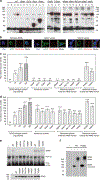Widening of the genetic and clinical spectrum of Lamb-Shaffer syndrome, a neurodevelopmental disorder due to SOX5 haploinsufficiency
- PMID: 31578471
- PMCID: PMC9063678
- DOI: 10.1038/s41436-019-0657-0
Widening of the genetic and clinical spectrum of Lamb-Shaffer syndrome, a neurodevelopmental disorder due to SOX5 haploinsufficiency
Abstract
Purpose: Lamb-Shaffer syndrome (LAMSHF) is a neurodevelopmental disorder described in just over two dozen patients with heterozygous genetic alterations involving SOX5, a gene encoding a transcription factor regulating cell fate and differentiation in neurogenesis and other discrete developmental processes. The genetic alterations described so far are mainly microdeletions. The present study was aimed at increasing our understanding of LAMSHF, its clinical and genetic spectrum, and the pathophysiological mechanisms involved.
Methods: Clinical and genetic data were collected through GeneMatcher and clinical or genetic networks for 41 novel patients harboring various types ofSOX5 alterations. Functional consequences of selected substitutions were investigated.
Results: Microdeletions and truncating variants occurred throughout SOX5. In contrast, most missense variants clustered in the pivotal SOX-specific high-mobility-group domain. The latter variants prevented SOX5 from binding DNA and promoting transactivation in vitro, whereas missense variants located outside the high-mobility-group domain did not. Clinical manifestations and severity varied among patients. No clear genotype-phenotype correlations were found, except that missense variants outside the high-mobility-group domain were generally better tolerated.
Conclusions: This study extends the clinical and genetic spectrum associated with LAMSHF and consolidates evidence that SOX5 haploinsufficiency leads to variable degrees of intellectual disability, language delay, and other clinical features.
Keywords: autism; developmental delay; epilepsy; intellectual disability; missense variants..
Conflict of interest statement
DISCLOSURE
M.J.G.S., K. McWalter, R.E.S., and Z.Z. are employees of GeneDx, Inc. S.I. is employed by Ambry Genetics, a company that provides testing for multigene panels and medical exome sequencing. The Department of Molecular and Human Genetics at Baylor College of Medicine receives revenue from clinical genetic testing performed at Baylor Genetics Laboratories. The other authors declare no conflicts of interest.
Figures




References
-
- Kamachi Y, Kondoh H. Sox proteins: regulators of cell fate specification and differentiation. Development. 2013;140:4129–4144. - PubMed
-
- Bowles J, Schepers G, Koopman P. Phylogeny of the SOX family of developmental transcription factors based on sequence and structural indicators. Dev Biol. 2000;227:239–255. - PubMed
-
- Sim H, Argentaro A, Harley VR. Boys, girls and shuttling of SRY and SOX9. Trends Endocrinol Metab. 2008;19:213–222. - PubMed
Publication types
MeSH terms
Substances
Grants and funding
LinkOut - more resources
Full Text Sources
Other Literature Sources
Miscellaneous

